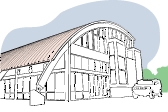
Arched roofs offer excellent structural strength, and an unusual and eye-catching design. Nowadays, arched roofs are typically made from curved steel.

What are arched and curved roofs?
In the world of construction, the arch is a design of both aesthetic and engineering beauty. It has a pleasingly curved shape, which can be tweaked in a number of ways to result in different silhouettes. Provided they’re designed properly too, arched roofs are also a self-supporting structure. With adequate reinforcement (i.e thick or buttressed walls), an arch may even be load bearing.
An arched roof extends the structural capabilities of the arch by placing a roof over a series of parallel arches. The space that is created once an arched roof is installed is called a vault. The vaulted roof and the barrel vault roof are two common forms of arched roofs. Arches were the precursor to circular or domed roof, which are are engineered in a similar but slightly more complex fashion.
Why install an arched roof?
Arched roofs are very ornamental, and are most commonly used to give a very particular historical look to a home – or to provide some amazing space and acoustics. Arches are most commonly found in grand old homes and churches – many of which are nowadays being bought and renovated into homes.
Installing an arched roof will give your home a striking one-of-a-kind appearance and offer excellent resistance to water and strong winds, but it’s important to take into account just how much cost and effort is involved in installing an arched roof. Even more importantly, you should consider whether or not it’s likely to be ‘appropriate’ for where and what you’re building.
Arched roofs are often the most prominent architectural feature of buildings they appear on, and may dictate how many other aspects of the home need to be built.
What materials are used in an arched roof?
Traditional arches are made from stone or wood. Arched roofs can also be made from steel or concrete.
|
Advantages
|
Disadvantages
|





